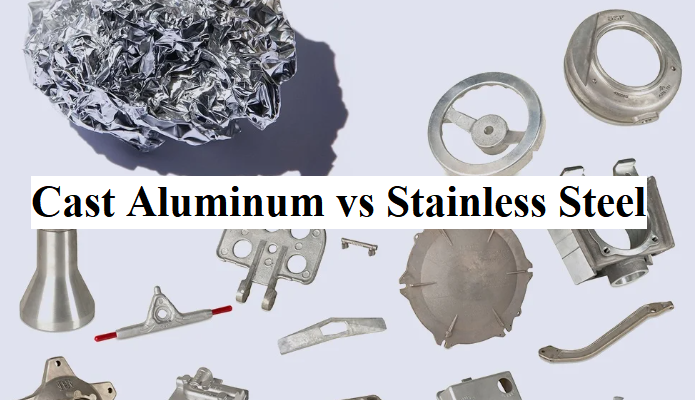Cast aluminum and stainless steel are two popular materials used in various industries, cast aluminum vs stainless steel, what’s the difference, and which one is the preferred choice for your application?

What Is Cast Aluminum?
Cast aluminum refers to aluminum that has been melted and poured into a mold to create a desired shape. The process of casting aluminum involves melting the aluminum at high temperatures, then pouring it into a mold and allowing it to cool and solidify. Cast aluminum is commonly used in the production of various types of products, such as automotive parts, cookware, and outdoor furniture, due to its durability, lightweight, and ability to withstand high temperatures.
Advantages of Cast Aluminum:
Lightweight: Cast aluminum is significantly lighter than many other metals, which makes it easy to handle during manufacturing and transportation.
Good heat conductivity: Cast aluminum has excellent heat conductivity, which makes it ideal for use in applications where heat transfer is essential.
Corrosion resistance: Cast aluminum has good resistance to corrosion and rust, which makes it ideal for outdoor applications and high humidity environments.
Malleability: Cast aluminum is highly malleable, which allows it to be easily shaped into intricate and complex designs.
Cost-effective: Cast aluminum is generally less expensive to produce than other metals, making it a cost-effective option for many applications.
Disadvantages of Cast Aluminum:
Lower strength: Cast aluminum is not as strong as many other metals, which makes it less suitable for applications requiring high strength and durability.
Susceptibility to cracking: Cast aluminum is more prone to cracking and fatigue failures than some other metals, especially when exposed to high stress or pressure.
Difficulty in welding: Cast aluminum can be difficult to weld, especially without proper training and equipment.
Limited wear resistance: Cast aluminum can wear out more quickly than other metals, which may require more frequent replacement or maintenance.
Potentially lower melting point: Cast aluminum generally has a lower melting point than other metals, which limits its use in high-temperature environments.
Cast Aluminum vs Stainless Steel, What Are the Differences
1. Composition: Cast aluminum is an alloy made primarily of aluminum, while stainless steel is made of a combination of iron, chromium, and other metals.
2. Strength and Durability: Stainless steel is denser and harder than cast aluminum, making it stronger and more durable. Cast aluminum is lightweight and less dense, which makes it less strong but more malleable.
3. Corrosion Resistance: Stainless steel has a high resistance to corrosion because of its chromium content. While cast aluminum can also resist corrosion, it is more susceptible to degradation than stainless steel in corrosive environments.
4. Heat Resistance: Cast aluminum has good heat conductivity, but is less resistant to high temperatures than stainless steel. Stainless steel has superior heat resistance and is often used for applications where high temperatures are involved.
5. Cost: Cast aluminum is generally less expensive than stainless steel due to the cost of raw materials and manufacturing processes.
6. Applications
Applications of Cast Aluminum:
– Automotive industry: Cast aluminum is used in the production of engine components, pistons, and other parts in the automotive industry due to its lightweight and high strength-to-weight ratio.
– Outdoor furniture: Cast aluminum is commonly used in the production of outdoor furniture due to its resistance to corrosion, lightweight, and ability to withstand exposure to the elements.
– Cookware: Cast aluminum is used in the production of cookware, such as frying pans and Dutch ovens, because of its ability to conduct and distribute heat evenly.
– Electrical and electronics industry: Cast aluminum is used in the electrical and electronics industry for making housings for a variety of electronic devices, such as computers, televisions, and smartphones due to its lightweight and good thermal conductivity.
Applications of Stainless Steel:
– Aerospace industry: Stainless steel is commonly used in the aerospace industry for manufacturing aircraft components, such as jet engine parts and airframes.
– Medical equipment: Stainless steel is used for the production of medical equipment due to its durability, resistance to corrosion, and ease of sterilization.
– Food processing: Stainless steel is often used in food processing equipment, such as mixing tanks, storage tanks, and conveyor systems, due to its hygienic properties and corrosion resistance.
– Architecture and construction: Stainless steel is used in building and construction to create durable and corrosion-resistant structures like railings, facades, and roofs.

